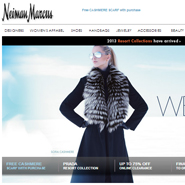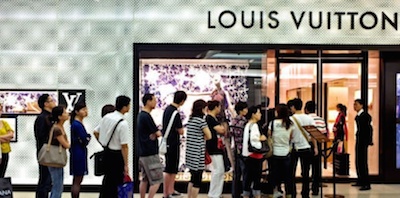 Neiman Marcus ecommerce site
Neiman Marcus ecommerce site
Global heterogeneity presents many obstacles for brands looking to maximize their share through localization efforts, according to a new report from L2.
The share of ecommerce sales in the luxury industry has tripled since 2009 and is set to triple again by 2025, but obstacles such as currency, language, selection and payment method may make it difficult for brands to expand and capitalize on their reach. As social media, the Web, and the development of BRIC, Asian, and Sub-Saharan Africa in the future give brands more visibility, it is essential that they monetize global consumers.
"There are a number of different components of different components to this problem of whether to offer ecommerce in a country or not," said Mabel McLean, study lead at L2's intelligence group. "It's expensive to launch [a fully localized ecommerce site], but there definitely is a disconnect between where brands offer ecommerce worldide and where maybe they should be offering ecommerce worldwide."
L2's "Intelligence Report: Localization 2015" looks at 67 global brands in seven different categories from 10 different countries, examining their operations in each of the countries, with particular focus paid to ecommerce and mobile commerce efforts. Difficulties in global ecommerce operations include everything from translating Web sites to controlling prices and offering preferred methods of payment, finding that what brands offer and where they offer it are incongruous with wants and needs in each locale.
Diverse ecommerce
Consumers in Japan and China do a considerable amount of their shopping for luxury goods outside their country, meaning brands have ample opportunity to ship goods to high-end consumers who desire Western goods, yet only 67 percent of the global brands – which include nine luxury brands and a handful of other premium brands, as well as brands from South Korea, China, Japan and Russia – offer ecommerce in Japan and 54 percent offer ecommerce in China, suggesting an underuse of high-demand markets, particularly among Western luxury brands.
 Chinese consumers queue at a Louis Vuitton store
L2's study also shows that 43 percent of Internet users who purchase goods from international brands do so because the brand or product is not available in their own country, and two-thirds do so to take advantage of better prices.
The opportunity to fill a niche is one all brands can take advantage of, but fluctuations in currency, export costs and expenses related to maintaining effective ecommerce sites often lead to higher prices in international markets. Half of online shoppers also compare prices and research products before making a purchase, making it more difficult still for luxury brands to compete internationally. If consumers feel they are being exploited, the brand’s image and bottom-line will suffer.
Chinese consumers queue at a Louis Vuitton store
L2's study also shows that 43 percent of Internet users who purchase goods from international brands do so because the brand or product is not available in their own country, and two-thirds do so to take advantage of better prices.
The opportunity to fill a niche is one all brands can take advantage of, but fluctuations in currency, export costs and expenses related to maintaining effective ecommerce sites often lead to higher prices in international markets. Half of online shoppers also compare prices and research products before making a purchase, making it more difficult still for luxury brands to compete internationally. If consumers feel they are being exploited, the brand’s image and bottom-line will suffer.
 Tom Ford mobile commerce site
Many luxury brands may flinch at lowering prices, but some, such as Chanel and Burberry, have already taken steps to even out prices in varying markets, but the parity in the international ecommerce market continues to lag behind.
Openness of price has driven a race to the bottom, as discounts can no longer kept to one channel or store. Discount stores enable a retailer to reach more consumers at varying price points, but a growth strategy that favors off-price bricks-and-mortar may in time hurt the full-line store’s luxury image. This requires a delicate balancing act for retailers to retain their branding, positioning and pricing strategy (see story).
Maximizing mobile
Each international market is different, so brands must adapt local ecommerce sites to the needs of each country, from the site’s language to the currency in which prices appear to the methods of payment. In Germany, for example, PayPal and invoices are far more popular than credit card payment, yet barely half of brands allow payment PayPal and only a tenth by invoices while all take payment by credit card.
Different markets have also embraced mobile commerce at different rates, but those rates are not always proportionate to the mobile friendliness of brand sites.
For example, in France, 82 percent of brands have mobile friendly local sites, but mobile accounts for only one-fifth of transactions. In Russia, the numbers are similar.
On the other hand, brands lag behind both in offering preferred payment methods and in having mobile friendly Web sites in South Korea, but mobile transactions nonetheless account for nearly half of transactions. In China, a mere two-thirds have mobile-friendly sites despite spurring over a third of retail. Optimizing mobile and adapting local payment methods in these countries will likely result in increased revenue, but fully localized sites are difficult and may compromise the unity of a brand's message.
"All the luxury brands we looked at were offering the same site content [everywhere], there was no localization effort," Ms. McLean said. "But usually when you look at luxury brands, their messages are a little bit more transcendent than other brands."
Brands cannot take a unilateral approach to ecommerce. Instead, they must approach each market individually and tailor platforms in accordance with that country, from more obvious components like currency and language to subtler aspects of payment methods and mobile optimization.
For reluctant brands, one potential solution that brands are already starting to take is to partner with dedicated ecommerce platforms.
Tom Ford mobile commerce site
Many luxury brands may flinch at lowering prices, but some, such as Chanel and Burberry, have already taken steps to even out prices in varying markets, but the parity in the international ecommerce market continues to lag behind.
Openness of price has driven a race to the bottom, as discounts can no longer kept to one channel or store. Discount stores enable a retailer to reach more consumers at varying price points, but a growth strategy that favors off-price bricks-and-mortar may in time hurt the full-line store’s luxury image. This requires a delicate balancing act for retailers to retain their branding, positioning and pricing strategy (see story).
Maximizing mobile
Each international market is different, so brands must adapt local ecommerce sites to the needs of each country, from the site’s language to the currency in which prices appear to the methods of payment. In Germany, for example, PayPal and invoices are far more popular than credit card payment, yet barely half of brands allow payment PayPal and only a tenth by invoices while all take payment by credit card.
Different markets have also embraced mobile commerce at different rates, but those rates are not always proportionate to the mobile friendliness of brand sites.
For example, in France, 82 percent of brands have mobile friendly local sites, but mobile accounts for only one-fifth of transactions. In Russia, the numbers are similar.
On the other hand, brands lag behind both in offering preferred payment methods and in having mobile friendly Web sites in South Korea, but mobile transactions nonetheless account for nearly half of transactions. In China, a mere two-thirds have mobile-friendly sites despite spurring over a third of retail. Optimizing mobile and adapting local payment methods in these countries will likely result in increased revenue, but fully localized sites are difficult and may compromise the unity of a brand's message.
"All the luxury brands we looked at were offering the same site content [everywhere], there was no localization effort," Ms. McLean said. "But usually when you look at luxury brands, their messages are a little bit more transcendent than other brands."
Brands cannot take a unilateral approach to ecommerce. Instead, they must approach each market individually and tailor platforms in accordance with that country, from more obvious components like currency and language to subtler aspects of payment methods and mobile optimization.
For reluctant brands, one potential solution that brands are already starting to take is to partner with dedicated ecommerce platforms.
Last week, British online fashion retailer Farfetch announced that it is expanding its network to include brands using a new business model, Farfetch Black & White.
Farfetch serves as an ecommerce platform for independent boutiques that lack resources to host their own online marketplaces. The expansion is similar to the ecommerce model of retailer Yoox, which also has an online marketplace and powers the Web sites of numerous brands, will give global consumers access to a brands’ full array of product (see story).
More likely, though, this is an obstacle that brands will have to overcome themselves.
"When you do see that outsourcing of responsibility, a lot of localization isn’t at the top of the mind," Ms. McLean said. "It's tough to get that if you aren’t doing it internally in the organization yourself."
Final Take Forrest Cardamenis, editorial assistant on Luxury Daily, New York